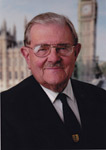By John Walton (Lord Walton of Detchant) Kt, TD, MA, MD, DSc, FRCP, FMedSci

John Walton
Ted Munsat was a close and much-valued friend whom I admired as a man, as a neurologist, as a teacher, and as an administrator and lifelong supporter of the World Federation of Neurology. I first met him many years ago (more years than I can remember with accuracy) when we both attended a conference in the United States on neuromuscular disease. I recognized at once that here was a man of outstanding ability and exceptional merit. Subsequently, we corresponded, and I think we even wrote one short paper together.
But perhaps my memory is sharpest of the time that he came to spend a year in my department in Newcastle. During that time, working with Peter Hudgson and others, he did some important original work leading to the publication of a number of papers, and he was widely respected and admired by the junior staff and by those working in research in the Muscular Dystrophy laboratories.
He was an immensely approachable man, full of advice and sensible comments. His contributions to the department’s work were exceptional, and I remember how proud he was when his young son took up soccer at a Newcastle school and ended up playing for the junior first team, where he was regarded as one of its stars.
Subsequently, I kept in close touch with him when he became head of department in Boston, and I forgave him, eventually, for stealing Walter Bradley from Newcastle to work with him, before Bradley went off to independent chairs, first in New Hampshire and later in Miami.
We continued to keep in close touch, and I was impressed with the work that he did on various WFN committees, and above all his contributions to continuing education in neurology through the publication of Continuum.
His wife Carla was a great charmer with a wonderful, twinkling attitude about life. They loved the social life in Newcastle, and later still, I met them both on many occasions at international meetings, and shared not only reminiscences but also their joint views about the future of neurology on a worldwide scale. Munsat has left a mark on international neurology that can never be erased, and he will be remembered by all who knew him with respect, pleasure and affection.













 Please join us for the 14th Asian and Oceanian Congress of Neurology (AOCN) March 2-5 at the Convention and Exhibition Centre of The Venetian® Macao.
Please join us for the 14th Asian and Oceanian Congress of Neurology (AOCN) March 2-5 at the Convention and Exhibition Centre of The Venetian® Macao.
 Young individuals born between 1981 and 1999 belong to Generation Y (Gen-Y). They are also called Digital Natives. In contrast to their parents belonging to the Baby Boomer generation, Gen-Y individuals are comfortable with the World Wide Web. They expect to find all information online, they rapidly adopt new online services and appreciate interacting digitally. Residents and young neurologists are mainly now recruiting from this new generation. Gen-Y neurologists do show fundamental different knowledge acquisition strategies mainly focused on online resources, challenging not only online services, but also training and teaching1,2.
Young individuals born between 1981 and 1999 belong to Generation Y (Gen-Y). They are also called Digital Natives. In contrast to their parents belonging to the Baby Boomer generation, Gen-Y individuals are comfortable with the World Wide Web. They expect to find all information online, they rapidly adopt new online services and appreciate interacting digitally. Residents and young neurologists are mainly now recruiting from this new generation. Gen-Y neurologists do show fundamental different knowledge acquisition strategies mainly focused on online resources, challenging not only online services, but also training and teaching1,2.


